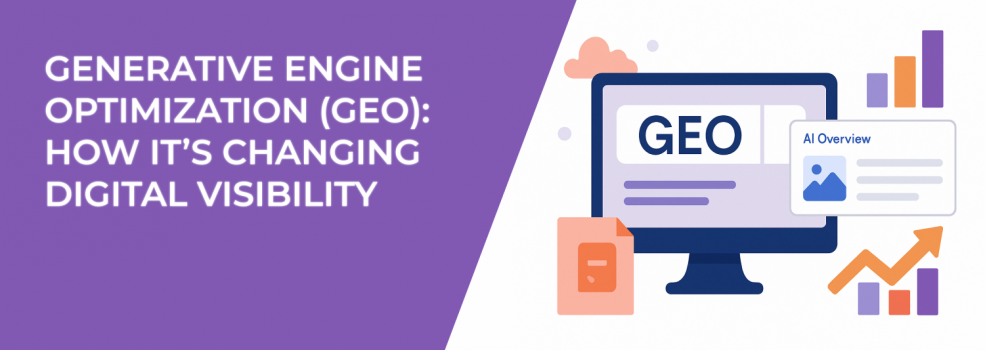Search is changing — in a big way.
People are no longer just typing keywords into Google and clicking on links. Now, they’re asking full questions — and getting direct answers from AI tools like ChatGPT, Perplexity, and Google’s Search Generative Experience (SGE).
This shift is opening up a new playing field for digital marketers. It’s called Generative Engine Optimization (GEO) — and it’s not just another SEO trend. It’s a different way of thinking about how people find you online.
If you’re new to this concept, here’s a helpful introduction: What is Generative Engine Optimization (GEO), and Why It Matters for Marketers.
Instead of trying to rank in the top 10 search results, you’re aiming to be part of the answer. GEO helps your content show up when AI tools generate summaries, lists, or recommendations. It’s all about being selected — not just seen.
So how exactly does GEO change your digital visibility? Let’s take a closer look.
GEO moves you from rankings to relevance
With traditional SEO, the goal was clear: get your page to rank high on a search results page. But with GEO, that goal shifts. You’re not just competing for clicks — you’re trying to be the content that gets quoted, cited, or summarized in an AI-generated response.
That’s a big change. Because in generative search, users often don’t scroll through links at all. If your content is selected as part of the answer, your brand becomes more visible — even if no one clicks a thing.
This type of visibility happens earlier in the customer journey and it builds trust quickly.
If you want a side-by-side breakdown of how GEO compares to traditional search optimization, this deep dive is worth a read: GEO vs SEO: How Generative Engine Optimization Changes Search Marketing.
GEO favors well-structured, easy-to-understand content
Generative engines don’t just scrape content — they try to make sense of it. That’s why structure matters more than ever. AI tools prefer content that’s organized, scannable, and easy to break into snippets.
What does that look like in practice?
-
Use clear, helpful headings — especially ones that reflect real questions people ask.
-
Break things into bite-sized sections — with short paragraphs, bulleted lists, and summaries.
-
Explain your points — instead of just naming features or tactics, give a quick reason why they matter.
The easier it is for an AI tool to find and understand your key points, the more likely it is to include them in an answer.
GEO puts real questions at the center of your strategy
People don’t ask AI tools for keywords — they ask questions. That’s why GEO content should be built around answering those questions clearly and directly.
Start by thinking about what your audience actually wants to know. Are they searching for strategies, comparisons, or how-to advice? Use those insights to shape your content.
Here’s what helps:
-
Make each question a section heading — that way, both readers and AI can find the answers fast.
-
Answer the question right away — don’t bury the lead. Give a clear answer first, then add context.
-
Write like you’re talking to someone — natural, helpful language wins over robotic or overly technical writing.
This question-first approach improves the user experience — and gives AI models a reason to quote your content.
GEO rewards depth — not just one-off blog posts
Having one good article used to be enough to rank in search. That’s no longer the case. Generative engines look for consistent, reliable sources — and they tend to favor websites that go deep on a topic.
That means your strategy needs to go beyond single posts. Instead, think about building a library of content around each subject.
-
Create content clusters — cover a topic from different angles, from beginner tips to advanced tactics.
-
Link related articles together — show that your site is a go-to resource, not just a one-time stop.
-
Update content regularly — fresh content shows AI models that your site is active and trustworthy.
In short, GEO visibility grows with consistent, in-depth coverage. Shallow content won’t cut it.
GEO boosts content that feels trustworthy and real
AI tools don’t pull just any content — they look for sources that feel credible. That means your content needs to show signs of real people behind it — and real effort put into it.
Here’s how to make your content more trustworthy:
-
Include a real author name and bio — even a short one builds confidence.
-
Cite reputable sources — link to respected studies, platforms, or tools that support your points.
-
Avoid clickbait or vague claims — be specific, accurate, and honest.
The more your content looks and feels like it was made to help someone — not just to rank — the more likely it is to be picked up by generative engines.
GEO expands your reach beyond traditional search
GEO isn’t just about Google anymore. People are using ChatGPT, Claude, Perplexity, Bing Copilot — and these platforms are becoming trusted discovery tools.
If your content is structured well, up to date, and clearly written, it can show up in answers across all of these tools — not just in one search engine.
To stay visible:
-
Use plain language — clarity is more powerful than complexity.
-
Make your key points stand out — add summaries or TL;DR boxes where it makes sense.
-
Keep things fresh — AI tools are more likely to pull from content that reflects the current state of the world.
Being found is no longer just about clicks — it’s about trust, usefulness, and timing.
GEO changes how you measure success
Unlike traditional SEO, GEO doesn’t offer rankings you can track on a dashboard. That makes performance a little harder to measure — but not impossible.
Here’s how to start:
-
Test your content manually — type your target questions into ChatGPT or Perplexity and see what shows up.
-
Compare what content gets quoted — study the tone, structure, and detail level of the sources being cited.
-
Adjust your format and test again — small changes in structure or phrasing can make a big difference.
Success in GEO is about being noticed — even if no one clicks.
Final thought: GEO changes what it means to be visible
In the age of AI, the old rules of search are evolving. Getting found online isn’t just about being on page one — it’s about being part of the answer.
GEO helps you create content that earns trust, delivers value, and stands out in the world of generative search. By focusing on structure, clarity, and credibility, you make it easier for AI tools to choose you.
That’s the future of digital visibility — and it’s already here.

